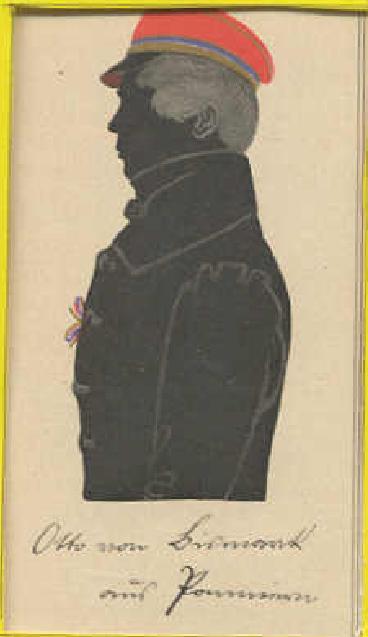
Count Otto von Bismarck: Education

Figure 1.--Silouettes were a popular art form in the early 19th century. This one of Bismarck was undated, but was probably made when he was a univerity student about 1832. The caption reads in German: Otto von Bismarck Otto von Bismarck aus Pommern (from Pomerania).
|
We have no information on Otto's first school. He was sent to Plamann Academy, a Spartan boarding school in Berlin, when he was 8 years old. He hated it and blamed his mother for sending him there.
At the age of 12 he began at the Graue Kloster high school, a gymnasium. He did not do well in school. His only good subject was German. Even in history he did poorly. His teachers thought him arrogant which undoubtdly was an accurate assessment.
He studied law in Hanover at the University of Göttingen. The liberal university was a strange choice for the aristocratic Bismarck who felt himself superior to the other students. His hatred of liberalism intensified during his time there. He joined a student association or corps and spent much of his time drinking with his fellows students. His was an aristocratic fraternity. Bismark showed no great aptitude as a student, except at dueling in the university. Out at place in the liberal atmpsphere at Göttingen, he eventually transferred to the University of Berlin. He passed his university examinations in 1835 at age 20, with the aid of a crammer.
Primary
We have no information on Otto's first school or perhaps he was tutored at home.
Plenum Academy
Bismarck was sent to board at the Plamann Academy, a Spartan boarding school in Berlin, when he was 8 years old. Religion and physical exercises dominated Hthe curriculum. He blamed his mother for sending him there. Even as an old man he remembered the severities there, the Spartan facilities, the poor food and the inadequate clothing. We suspect that part of the problem was that the coddled son of a Junker was for the first time treated like the other boys and he was used to more luxurious living conditions. He complained of being woken up in the morning with a rapier thrust. He resented the hostility of teachers and other boys toward the nobility. It was at this time that his hatred toward liberal ideas began to form. He always looked forward to return to Knieophof, the family home, for the summer, but summer after summer his mother would write saying that she had to visit some spa or another. He saw the school as a pentitentary. [Ludwig, pp. 8-9.]
Graue Kloster High School
At the age of 12 he began at the Graue Kloster high school, a gymnasium. He did not do well in school. His only good subject was German. Even in history he did poorly. His teachers thought him arrogant which undoubtdly was an accurate assessment. [Ludwig, pp. 10-11.]
University of Göttingen (1832-33)
Bismarck read law at the Universities of Göttingen (1832-33). Göttingen was is Hanover, one of the centres of German liberalism. This seems a strange for the artistocratic Prussian junker like Bismarck who felt himself superior to the other students.. I am not sure why he chose to go there. He felt out of place at University. He was the only Prussian Junker among largely middle class students, mostly with liberal outlooks. He apparently often absented himself from classes. He preferred to drink, duel and womanise. He dabbled in literature and philosophy. Bismarck is not at Göttingen long before he began dueling. A fellow student described at the time, "He had course scrubby hair, of a mixed color, something between red and whitey-brown. His face was pepered all over with fredkles, and his eyes were colourless in the centre, and looked as if edged with red tape. An enormous scar, the elic of a recent duel ... extended from the tip of his nose to the edge of his rght ear, and has been sewed up with fourteen stitches." [Motley] University students had detinctive caps (figure 1).
University of Berlin
Out at place in the liberal atmpsphere at Göttingen, he eventually transferred to the University of Berlin. The experience had made him a confirmed opponent of liberalim. He passed his university examinations in 1835 at age 20, with the aid of a crammer. [Ludwig, p. 20.]
As was common at the time for university students, he joined a student association or drinking club (corps)--the "Corps Hannovera" during 1832-33. [Allers and Kraemer] He fought numerous duels as part of the club as well as a result of his quarelsome nature. His first was when he thought a group of other students were laughing at him. Any preceived criticism of Prussian or the nobility, even in class discussions would elicit a challenge from Bismarck. He fights 25 duels in his first 3 terms. He once had six duels on his hand at one time. He ame to be feared by the other students. [Ludwig, pp. 14-17.] I Hannovera had 24 membersnames, only a few from the nobility ("von" in their name). Therewas one American, a certain Mitchell E. King from Charleston, South Carolina. We wonder if he and Bismarck had become friends. [Alders and Kraemer]
Sources
Allers, C.W. and Hans Kraemer. Unser Bismarck "Our Bismarck" (Union Deutsche Verlagsgesellschaft, Stuttgart, 1900).
Hoffman, J.H. Otto von Bismarck, 1998.
Ludwig, Emil. Bismarck: The Story of a Fighter (Little, Brown, and Company, 1927).
Christopher Wagner

Navigate the Boys' Historical Clothing Web Site:
[Return to the Main Bismarck page]
[Introduction]
[Activities]
[Biographies]
[Chronology]
[Clothing styles]
[Countries]
[Bibliographies]
[Contributions]
[FAQs]
[Glossaries]
[Satellite sites]
[Tools]
[Boys' Clothing Home]
Created: September 25, 2002
Last updated: September 26, 2002



